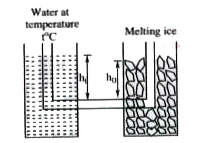Passage - II :
Liquids do not have definite shape and size, they are taken in a vessel. Their expansion (or) contraction takes place with respect to the container in which they arc considered. The volume coefficient of expansion relative to the vessel is termed as coefficient of apparent expansion (γa) and the volume coefficient of expansion of the liquid is termed as absolute (γRorγL). In some of the arrangements mentioned as per the instructions. solve the problems.
A thread of liquid in a uniform capillary tube of length L, as measured by a ruler. The temperature of the tube and the thread of the liquid is raised by 'Δθ'. If γ is the coefficient of volume expansion of the liquid and α is the coefficient of linear expansion of the material of the tube, then the increase in length 'ΔL' of the thread as measured by the ruler will be
ΔL=L(γ−α)Δθ
ΔL=(γ−2α)Δθ
ΔL=L(γ−3α)Δθ
Δ=Lγ(Δθ)
The correct Answer is:D
Topper's Solved these Questions
- THERMAL PROPERTIES OF MATTERBOOK - AAKASH SERIESCHAPTER - THERMAL PROPERTIES OF MATTEREXERCISE - EXPANSION OF LIQUIDS (PRACTICE SHEET) LEVEL-II (Matrix Matching Type Questions)
3 Videos
- THERMAL PROPERTIES OF MATTERBOOK - AAKASH SERIESCHAPTER - THERMAL PROPERTIES OF MATTEREXERCISE - EXPANSION OF LIQUIDS (PRACTICE SHEET) LEVEL-II (Integer/Subjective Type Questions)
4 Videos
- THERMAL PROPERTIES OF MATTERBOOK - AAKASH SERIESCHAPTER - THERMAL PROPERTIES OF MATTEREXERCISE - EXPANSION OF LIQUIDS (PRACTICE SHEET) LEVEL-II (More than One correct answer Type Questions)
5 Videos
- SYSTEM OF PARTICLES AND ROTATIONAL MOTIONBOOK - AAKASH SERIESCHAPTER - SYSTEM OF PARTICLES AND ROTATIONAL MOTIONEXERCISE - PRACTICE EXERCISE
99 Videos
- THERMODYNAMICSBOOK - AAKASH SERIESCHAPTER - THERMODYNAMICSEXERCISE - EXERCISE - 3
33 Videos
Similar Questions
A cylindrical isotropic solid of coefficient of thermal expansion α and density ρ ( at STP) floats partially in a liquid of coefficient of volume expansion (γ) and density d ( at STP )
Column-IColumn-IIA) Volume of the cylinder inside the liquid remains constantP)γ=0B) Volume of cylinder outside the liquid remains constantQ)γ=2αC) Height of the cylinder outside the liquid remains constantR)γ=3α(dρ)D) Height of the cylinder inside the liquid remains constantS)γ=[2α+α(dρ)]
View SolutionIn figure shown, left arm of a U-tube is immersed in a hot water bath at temperature T, and right arm is immersed in a bath of melting ice, the height of monomeric liquid in respective columns is htandh0. Determine the coefficient of expansion of the liquid

View SolutionIron floats over mercury because density of mercury is more than the density of iron. Coefficient of volumetric expansion of iron and mercury are35×10−6∘C−1.and180×10−6∘C−1. Now consider an iron cube floating in a bowl of mercury at 0∘C. When temperature is increased upt0 25∘C. then choose the correct options.
View SolutionThe centre of mass of two particles with masses 2kg and 6 kg located at (1,1,1), (2,2,1) respectively has the coordinates
View SolutionA bullet of mass 10×10−3 moving with a speed of 20ms−1 hits an ice block (0∘C) of 990g kept at rest on a frictionless floor and gets embedded in it. If ice takes 50% of K.E, the amount of ice melted (in grams) approximately is (J=4.2J/cal) (latent heat of ice=80cal/g)
View SolutionThe absolute coefficient of expansion of a liquid is 7 times that the volume coefficient of expansion of the vessel. Then the ratio of absolute and apparent expansion of the liquid is
View SolutionThe coefficient of real expansion of liquid is gamma_(R) and the coefficient of appareent expansion of the liquid is gamma_(A) . The coefficient of cubical expansion of the vessel is gamma . If gamma_(R) : gamma_(A) = 4:1 then gamma_(A) : gamma is
View SolutionCoefficient of apparent expansions of a liquid in two different vessels are a and b. Then the real coefficient of expansions of liquids, if the ratio of volume expansion of vessel of x:y
View SolutionThe apparent coefficients of volume expansion of a liquid when heated filled in vessel A and B of identical volumes, are found to be gamma_(1) and gamma_(2) respectively. If alpha_(1) be the coefficient of liner expansion for A, then what will be the be the coefficient of linear expansion for B? (True expansion - vessel expansion = app.exp)
View SolutionThe coefficients of apparent expansion of a liquid when determined using two different vessels A and B are gamma_(1)" and "gamma_(2) respectively. If the coefficient of linear expansion of the vessel A is alpha . The coefficient of linear expansion of the vessel B is
View SolutionIf the coefficient of apparent expansion of a liquid is (5)/(6) th of coefficient of absolute expansion then coefficient of cubical expansion of vessel is....Times coefficients of real expansion of the liquid
View SolutionThe coefficient of apparent expansion of a liquid for two different vessels A and B are γ1 and γ2 respectively. If the coefficient of linear expansion of the material of the vessel A is α, then the coefficient of linear expansion of the material of the vessel B will be
View SolutionStatement I : The coefficient of real expansion of the liquid is independent of the nature of container. Statement II : gamma_(r)=gamma_(a)+gamma_(v) " where " gamma_(r)= coefficient of real expansion, gamma_(a)= coefficient of expansion and gamma_(v)= coefficient of apparent expansion of vessel.
View SolutionPassage-II:
Coefficient apparent expansion of a liquid is γH=mass excelled (remaining mass) ( change in temperature)
In the above question coefficient of apparent expansion of the liquid is
View SolutionIf γR,γAandγV represent the coefficient of real expansion of a liquid, coefficient of apparent expansion, n of the liquid and coefficient of cubical expansion of the material of the vessel respectively, then which of the following is/are correct?
View Solution
